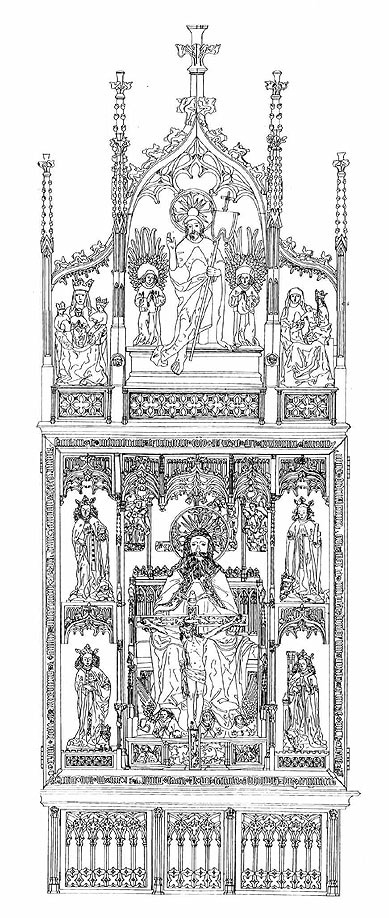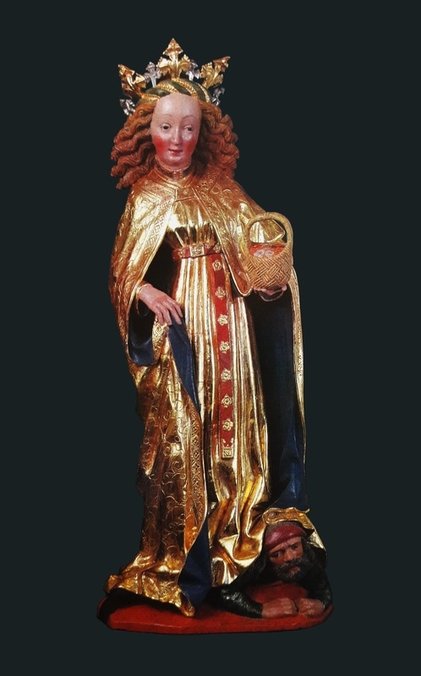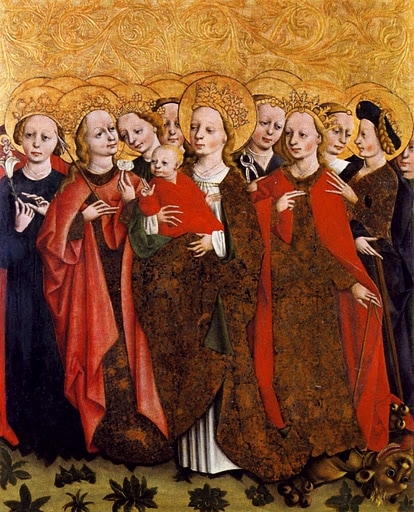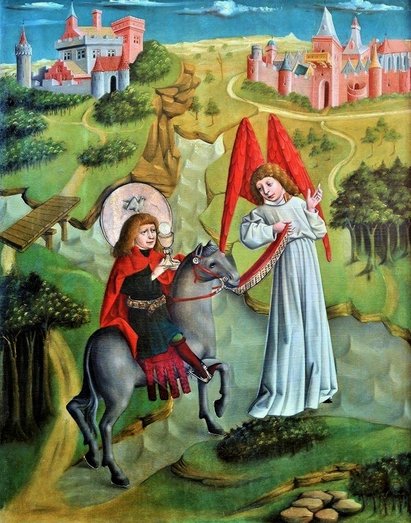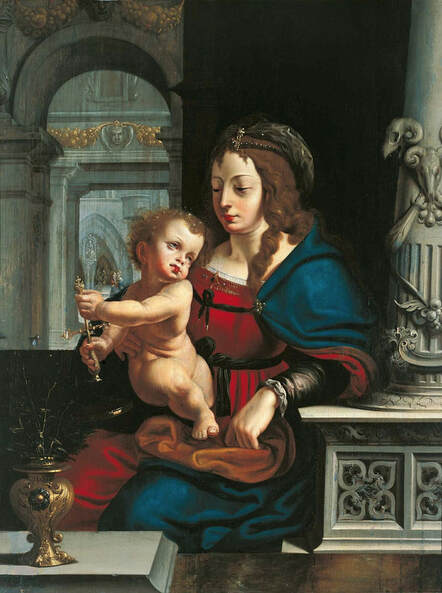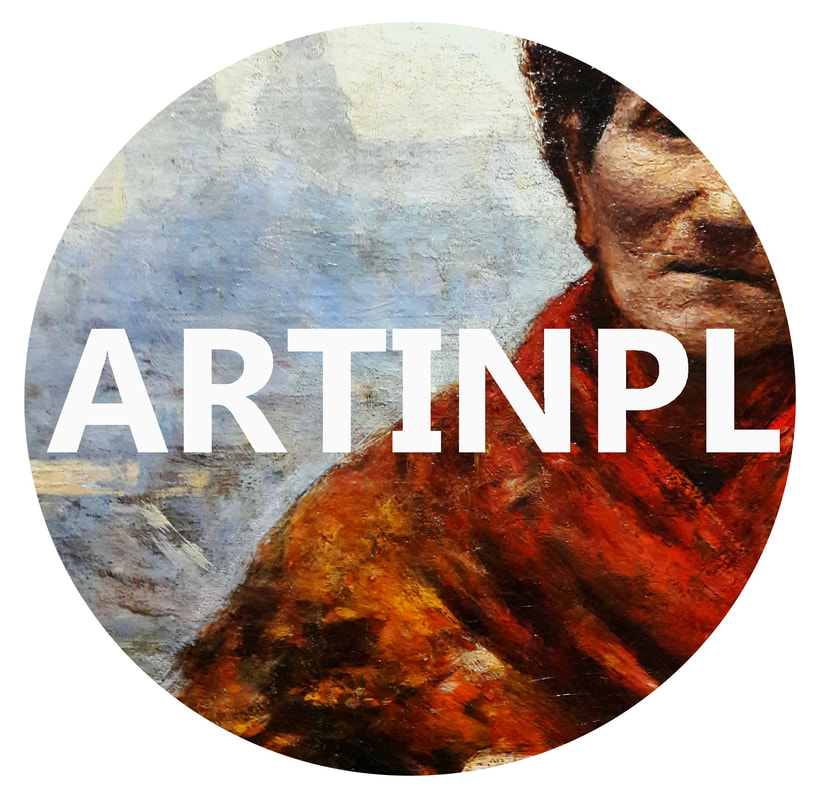|
The Holy Trinity Triptych occupying the east wall of the Holy Cross Chapel of the Wawel Cathedral, was most probably created by Kraków's workshop of Jakub of Sącz, also known as the Master of the Holy Trinity Triptych or Master of the Choirs. It was established as a retable for the opposite Chapel of the Holy Trinity, also known as the Chapel of Queen Sophia of Halshany. The Queen, fourth and last wife of Jogaila of Lithuania (Ladislaus II Jagiello), most probably also sponsored the altar for her chapel which was finally accomplished in 1464, although built much earlier (between 1431-1433). The retable has a figure of the Risen Christ with two angels, St. Sophia with her daughters, patron saint of the Queen, and St. Anne at the top. The central group of the Holy Trinity is accompanied with statues of saints Dorothy, Margaret, Catherine and Barbara and two painted wings with choirs of apostles, martyrs, prophets and virgins on inner sides and conversion of St. Paul, vision of St. Eustace, St. George killing the dragon and St. Secundus crossing the river Po in outer sides. In 1616 or before the altar was moved to the current location in the Holy Cross Chapel.
Central part of the Holy Trinity Triptych by workshop of Jakub of Sącz, 1467, Holy Cross Chapel of the Wawel Cathedral in Kraków.
Statue of St. Dorothy from the Holy Trinity Triptych by workshop of Jakub of Sącz, 1467, Holy Cross Chapel of the Wawel Cathedral in Kraków.
Choir of the Holy Virgins from the Holy Trinity Triptych by workshop of Jakub of Sącz, 1467, Holy Cross Chapel of the Wawel Cathedral in Kraków.
St. Secundus crossing the river Po from the Holy Trinity Triptych by workshop of Jakub of Sącz, 1467, Holy Cross Chapel of the Wawel Cathedral in Kraków.
Before 1516 the confraternity of Saint Reinhold in Gdańsk commissioned a retable for the Saint Reinhold Chapel of the Saint Mary's Church in the city. The outer wings of the polyptych were painted in the workshop of Joos van Cleve, who depicted himself as Saint Reinhold.
The polyptych was shipped to Gdańsk in 1516 and today is on display in the Gallery of Medieval Art of the National Museum in Warsaw (oak, central panel 194 × 158 cm (76.4 × 62.2 in), each wing 194 × 75 cm (76.4 × 29.5 in)). It is the first confirmed work commissioned by patrons from territories of today's Poland. The second could be Triptych with the Adoration of the Magi with a monarch in a chain of the Order of the Golden Fleece in the Gemäldegalerie, Berlin (oak, central panel 72 × 52 cm (28.3 × 20.5 in), each wing 69 × 22 cm (27.2 × 8.7 in)). It was acquired from the Reimer Collection in Berlin in 1843. Possibly commissioned by Sigismund I of Poland. The outer parts of the wings were painted en grisaille with effigies of Saints Christopher and Sebastian, which may indicate the donor, his patron saints, however among recipients of the Order of the Golden Fleece between 1451 and 1531 there were no Sebastian and only one Christopher - Christopher, Margrave of Baden-Hachberg (1453-1527). Although the latter was portraited in the similar headdress (crinale), he was not a king to depict himself as one of the Magi, and his facial features are completely different. Also other garments are very close to those from the known effigies of the Polish monarch - eg. Communion of Sigismund I, a leaf from the Prayer Book of Sigismund I the Old by Stanisław Samostrzelnik from 1524 in the British Library. The king of Poland was awarded the Order of the Golden Fleece in 1519 at the age of 52. The sources on artistic contacts of the Polish court at that time with the Netherlands are very scarce. Among commissions confirmed in preserved inventories and accounts there are the following. In 1526 queen Bona Sforza commissioned in Antwerp through Seweryn Boner, 16 tapestries "de lana cum figuris et imaginibus" of 200 flemish square inches in its entity. They were transported to Kraków via Frankfurt upon Main, Nuremberg and Wrocław. In 1533 king Sigismund I commissioned through Boner and Mauritius Hernyck in Antwerp 60 tapestries with coat of arms of Poland, Lithuania and Duchy of Milan among which 20 bigger with green and blue background, 26 tapestries without coat of arms and 6 tapestries with figural scenes. The commission cost was 1170 florins and tapestries were transported to Kraków via Nuremberg, Leipzig and Wrocław. In 1536 the king acquired 7 paintings in Flanders to adorn the apartments of prince Sigismund Augustus at the Wawel castle for 35 florins ("pro septem imaginibus Flandrensibus pictis"). The subtle marble bust of Queen Barbara Zapolya from Olesko Castle in the style of Netherlandish renaissance was probably part of a larger commission made by Sigismund I around 1520. Madonna and Child in architectural setting
oil on panel, ca. 1535, 33.6 × 25.2 cm (13.2 × 9.9 in), inventory number Wil.1591, Museum of King John III's Palace at Wilanów
The painting represents one of several versions of ''Madonna of the Cherries'' created by Giovanni Pietro Rizzoli, called Giampietrino in about 1508-1510 when he was working alongside Leonardo da Vinci. The Giampietrino's painting is possibly a reproduction of a Madonna painted by Leonardo for Francis I of France. The latter work was probably a painting that influenced Joos van Cleve who was frequently employed by French court. The painting by Giampietrino from doctor Karl Lanz's collection is a direct link to the lost da Vinci's original. The composition enjoyed great success in the early decades of the 16th century and some twenty three versions attributed to Joos van Cleve's workshop have been identified.
Similar painting is in the Arnold and Seena Davis Collection. The work was acquired by Stanisław Kostka Potocki for his collection in the Wilanów Palace in Warsaw. |
Artinpl is individual, educational project to share knowledge about works of art nowadays and in the past in Poland.
If you like this project, please support it with any amount so it could develop. © Marcin Latka Categories
All
Archives
April 2023
|
